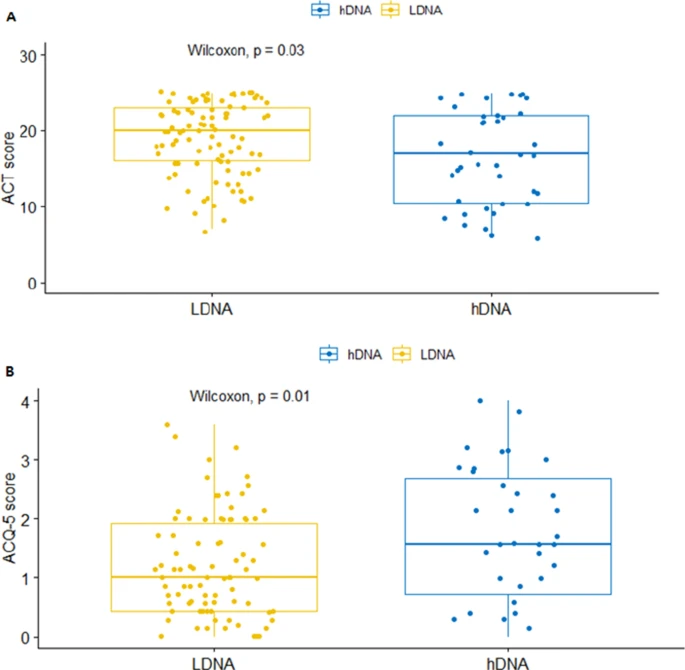Research – Open Access
Mustafa Abdo, Mohib Uddin, Torsten Goldmann, Sebastian Marwitz, Thomas Bahmer, Olaf Holz, Anne-Marie Kirsten, Frederik Trinkmann, Erika von Mutius, Matthias Kopp, Gesine Hansen, Klaus F. Rabe, Henrik Watz, Frauke Pedersen on behalf of the ALLIANCE study group
Abstract
Background
Extracellular DNA (e-DNA) and neutrophil extracellular traps (NETs) are linked to asthmatics airway inflammation. However, data demonstrating the characterization of airway inflammation associated with excessive e-DNA production and its impact on asthma outcomes are limited.
Objective
To characterize the airway inflammation associated with excessive e-DNA production and its association with asthma control, severe exacerbations and pulmonary function, particularly, air trapping and small airway dysfunction.
Methods
We measured e-DNA concentrations in induced sputum from 134 asthma patients and 28 healthy controls. We studied the correlation of e-DNA concentrations with sputum neutrophils, eosinophils and macrophages and the fractional exhaled nitric oxide (FeNO). Lung function was evaluated using spirometry, body plethysmography, impulse oscillometry and inert gas multiple breath washout. We stratified patients with asthma into low-DNA and high-DNA to compare lung function impairments and asthma outcomes.
Results

Patients with severe asthma had higher e-DNA concentration (54.2 ± 42.4 ng/µl) than patients with mild-moderate asthma (41.0 ± 44.1 ng/µl) or healthy controls (26.1 ± 16.5 ng/µl), (all p values < 0.05). E-DNA concentrations correlated directly with sputum neutrophils (R = 0.49, p < 0.0001) and negatively with sputum macrophages (R = − 0.36, p < 0.0001), but neither with sputum eosinophils (R = 0.10, p = 0.26), nor with FeNO (R = − 0.10, p = 0.22). We found that 29% of asthma patients (n = 39) had high e-DNA concentrations above the upper 95th percentile value in healthy controls (55.6 ng /μl). High-DNA was associated with broad lung function impairments including: airflow obstruction of the large (FEV1) and small airways (FEF50%, FEF25–75), increased air trapping (RV, RV/TLC), increased small airway resistance (R5-20, sReff), decreased lung elasticity (X5Hz) and increased ventilation heterogeneity (LCI), (all P values < 0.05). We also found that high e-DNA was associated with nearly three-fold greater risk of severe exacerbations (OR 2·93 [95% CI 1.2–7.5]; p = 0·012), worse asthma control test (p = 0.03), worse asthma control questionnaire scores (p = 0.01) and higher doses of inhaled corticosteroids (p = 0.026).
Conclusion
Increased production of extracellular DNA in the airway characterizes a subset of neutrophilic asthma patients who have broad lung function impairments, poor symptom control and increased risk of severe exacerbations.
